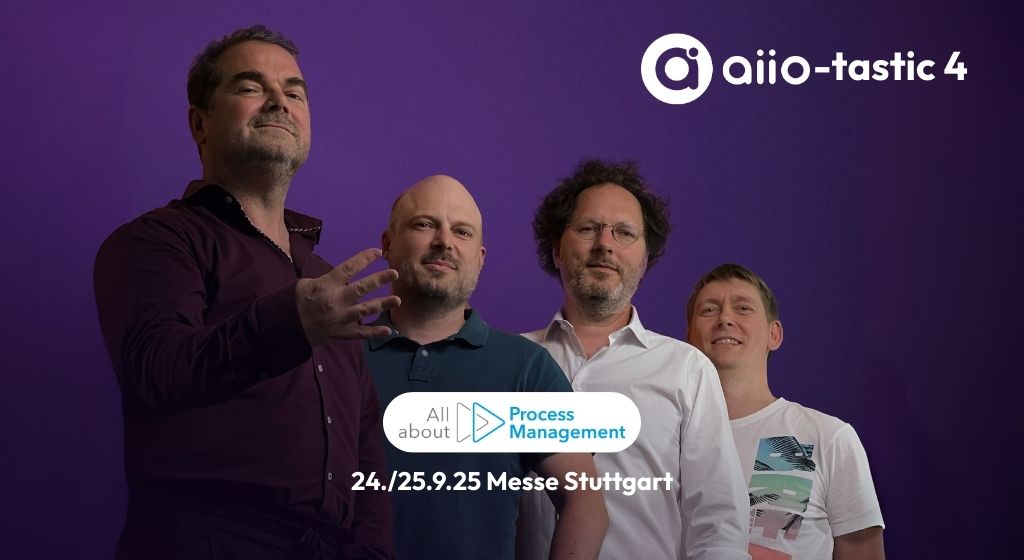Start process management efficiently: Optimization with a limited budget & AI

What is process management anyway?
At its core, process management means systematically improving the processes in your company. You plan, monitor and control your business processes - so that in the end everything runs more efficiently, with higher quality and more reliably.
The basics
In process management, you look at how things work in your company. Each process is a series of steps that work together to achieve a goal - regardless of whether you are manufacturing a product, processing customer inquiries or handling orders. The whole thing sounds abstract at first, but it's actually quite concrete: you identify your most important workflows, document them and then analyze where things are going wrong.
Why the effort is worth it
Maybe you're asking yourself now: Why should I go to all this trouble? The answer is simple: because it pays off. If you take a close look at your processes, you will quickly find unnecessary steps that you can eliminate. This makes you more efficient. At the same time, standardized processes ensure that your products or services are consistently good - regardless of who is currently working on them.
And then there is the question of costs. Less chaos and better use of resources also mean less expenditure in the end. A nice side effect: with clearly defined processes, you can react more quickly to changes in the market. You know exactly where to start if the framework conditions change.
Different paths to the goal
There is no one right approach to process management. Different methods fit better or worse depending on the situation and objectives. Business Process Management (BPM) is the classic approach and covers the entire life cycle of a process - from the initial sketch to long-term optimization. Lean management, on the other hand, focuses on avoiding waste. The idea: you only keep what really creates value for the customer, everything else is thrown out.
Six Sigma is strongly data-based and aims to minimize errors. Total Quality Management (TQM) goes one step further and focuses on continuous improvement in all areas. Which approach is right for you depends on your initial situation and your goals. A combination of different methods often makes sense.
How to get started
Getting started in process management doesn't have to be complicated. On the contrary: start small and work your way forward step by step. The biggest mistake you can make is to try to perfect everything at once.
Taking stock: where are you right now?
Before you optimize anything, you need to know how it is currently performing. This sounds trivial, but is surprisingly often skipped. So start by writing down the key processes in your company - production, customer service, orders and so on. Don't worry about completeness, it's about the biggest chunks.
Then you document these processes. Simple diagrams are completely sufficient, you don't need elaborate models. It is more important that you are clear about what you actually want to achieve. Shorter processing times? Better quality? Lower costs? You should formulate these goals as specifically as possible so that you can later measure whether you have achieved them.
What beginners should look out for
A few things make the difference between success and frustration. Transparency is at the top of the list: Everyone involved needs to know what's going on. Open communication is the be-all and end-all. If people don't understand why something is changing or how the new processes work, any optimization will fail.
At the same time, you should remain flexible. Be prepared to adapt things if they don't work. Processes evolve - this is completely normal and even desirable. Sticking rigidly to a plan that turns out to be impractical won't get anyone anywhere. And another thing: your people know the daily processes best. Listen to them. Their feedback is worth its weight in gold because they work with the processes every day and know exactly where the shoe pinches.
Setting the right priorities
With a limited budget, you can't tackle everything at once. The trick is to find out where to start. A cost-benefit analysis will help you do this: Which processes will give you the greatest benefit for the least effort?
Quick wins are particularly valuable - processes that you can improve significantly with little effort. These early successes are important because they motivate your team and show that the effort is worthwhile. At the same time, you should look for bottlenecks. Where are the biggest bottlenecks? Eliminating these bottlenecks often has the greatest effect on overall productivity because they slow down the entire process.
Tools that don't cost the earth
You don't need expensive software to get started. Microsoft Visio is the classic choice for diagrams and process models. Lucidchart also offers a free version that is perfectly adequate for getting started. If you're looking specifically for BPM software, aiio is a good choice - designed for process management and free to try. Bizagi is another free entry-level option that focuses on automation.
In addition to tools, you should also invest in your own knowledge. Platforms such as Coursera, Udemy or LinkedIn Learning have good courses on process management. Most of them are affordable and provide you with solid basic knowledge.
Process management on a tight budget
A limited budget doesn't mean you have to do without process management. It can also be done cheaply - or even free of charge. You just need to know where you can start and what free resources are available to you.
Proceed cost-efficiently
First things first: simplicity beats complexity. You don't need complex frameworks or expensive consultants to make tangible improvements. Common sense and a structured approach are often all you need. Implement changes step by step, not all at once. This allows you to evaluate the impact of each individual measure and minimizes the risk. If something doesn't work, you have only affected a small area and can quickly take countermeasures.
The trick is to focus on processes with the greatest leverage. A clean cost-benefit analysis will help you to identify the right candidates. Not every process is equally important, and not every optimization brings the same benefit. Invest your limited resources where they will have the greatest impact.
Plan your budget correctly
To make sure your project doesn't get out of hand, you need a plan. First, check what you already have in-house. What skills and resources do you already have? Perhaps you can use internal skills instead of buying in external help. This not only saves money, but also has the advantage that people already know your company.
Divide the project into phases and set a budget for each phase. This will help you keep an overview and prevent costs from exploding. A simple system for tracking expenditure is also important. Regular checks prevent nasty surprises and give you the opportunity to react early if it becomes apparent that you will exceed your budget.
Finding the right tools
Technology helps you to work more efficiently - and doesn't have to be expensive. Microsoft Visio is tried and tested for diagrams and process models and is also suitable for beginners. The learning curve isn't too steep, and you can find tons of tutorials online. Lucidchart offers free and affordable premium options for process visualization. The interface is intuitive and you can work directly in the browser.
aiio is a lean tool specifically for process management that is ready to go in under two minutes. You can test it for free and see if it suits your requirements. Bizagi focuses on process automation and also has a free entry-level version. Which tool is right for you depends on your specific needs. Feel free to try out a few before you commit.
Using AI as a lever
Artificial intelligence can significantly increase your ROI without you having to invest a fortune. AI takes over repetitive tasks so that your team can focus on more important things. This is particularly valuable because human labor is expensive and can be better used for strategic tasks than for mindless routine work.
Predictive analysis is another advantage: AI evaluates data and helps you to make better decisions and identify problems early on before they become real crises. AI also shows you where resources are being wasted and how you can make better use of them. These insights are often surprising and open your eyes to optimization potential that you didn't even have on your radar before.
AI in process management: revolution or hype?
Artificial intelligence is changing the way we optimize processes. But what are the real benefits and is it worth the effort? The answer is more nuanced than some marketing promises would have us believe, but is essentially positive.
What AI means in process management
AI systems can learn, solve problems and react to changes - just like humans, only faster and without getting tired. In process management, this means that huge amounts of data are analyzed and provide you with insights that you can work with. These systems recognize patterns that would escape the human eye, simply because they can process thousands of data points simultaneously.
The decisive difference to conventional software solutions: AI gets better over time. It learns from every process run and adapts its recommendations. This makes it particularly valuable for dynamic environments in which framework conditions are constantly changing.
The advantages at a glance
Automation is the most obvious advantage: AI takes care of recurring tasks and you save a huge amount of time. This applies not only to simple routine tasks, but increasingly also to more complex activities such as creating reports or prioritizing tasks. You can invest the time saved in strategic considerations that really require human judgment.
AI really comes into its own when it comes to data analysis. Sifting through large amounts of data quickly and recognizing patterns - that is the supreme discipline. While a human would need hours or days, AI delivers results in seconds. And it not only does this quickly, but also consistently, without fatigue or distraction affecting the quality.
Predictive analyses are particularly exciting. AI recognizes trends and helps you to act proactively instead of just reacting. You can see problems coming before they occur and can take countermeasures in good time. This gives you a real competitive advantage. And through machine learning, the system continuously improves itself. Each run makes the recommendations a little better without any additional effort on your part.
How to use AI successfully
Getting started with AI requires a clear strategy. First analyze which processes could benefit the most from AI. It doesn't make sense to use it everywhere. Choose areas in which a lot of data is generated, repetitive tasks dominate or complex patterns need to be recognized.
Start small with pilot projects. This helps you to test the technology without taking a big risk. You will learn how AI works in your specific context and can evaluate the results before making larger investments. An important point: the quality of your data is crucial. Bad data leads to bad results, no matter how good the AI is. So make sure your database is clean and structured.
Your team must be able to handle the new tools. Invest in training so that people understand how they can use AI and what the systems can do - but also where their limits lie. After successful pilot projects, you roll out the AI solution further. You can build on the experience gained during the test phase and avoid common stumbling blocks from the outset.
The aiio Copilot is a good example of how AI can help in practice. It generates specific optimization suggestions based on your processes. You no longer have to laboriously search for improvement opportunities yourself - the AI shows them to you.
What works well and what doesn't
To make your process management successful, you should know a few best practices - and avoid typical mistakes. The good news is that most of the pitfalls are known and can be avoided with a little attention.
Best Practices
Continuous improvement is not an option, but a must. Processes are never finished. The world is changing, your company is evolving, and your processes need to keep up. Establish a culture where continuous improvement is normal. The Japanese concept of Kaizen describes exactly this philosophy: getting a little better every day, without dramatic upheavals.
Involving all relevant stakeholders is also crucial. Employees, customers, partners - their perspectives are valuable and create acceptance. When people have the feeling that they are being heard and can help shape the process, they identify much more strongly with the results. This increases the likelihood that new processes will actually be put into practice and not just exist on paper.
Transparent communication cannot be emphasized enough. Keep everyone up to date on changes, progress and also setbacks. This creates trust and ensures that everyone is pulling in the same direction. Rumors and uncertainty are poison for any change project. Clear, open communication is the antidote.
Measure your success with key performance indicators (KPIs). You can't improve what you can't measure. This data helps you to find potential for improvement and monitor progress. At the same time, they show your team and management that your efforts are paying off. Stay flexible: Conditions change and you need to be ready to adapt. Technology can be a great helper here. AI, automation, data analysis - use these tools where they make sense.
Avoid typical mistakes
Many process management projects fail due to avoidable mistakes. Thinking too complex is one of the most common. Simplicity is often the better way. Complexity leads to confusion, error-proneness and inefficiency. If a process is so complicated that no one understands it, it will not be implemented correctly.
Poor documentation is another classic. If processes are not clearly documented, misunderstandings and errors arise. Everyone does it a little differently and quality and efficiency suffer. Documentation does not have to be perfect, but it must exist and be accessible to everyone. Ignoring feedback is particularly fatal. Your employees use the processes on a daily basis - their insights are worth their weight in gold. If you fall on deaf ears, you will quickly lose the motivation to speak up at all.
A lack of training means that new processes are not implemented correctly. Invest in training your team. Only those who understand the processes can apply them correctly and also make suggestions for improvement. Too much bureaucracy is counterproductive. Excessive administrative work slows you down and frustrates people. Keep it as lean as possible - as much structure as necessary, as little as possible.
The last big mistake: setting the wrong priorities. Not all processes are equally important, and not every optimization brings the same benefit. Focus on the processes with the greatest impact. There is no point in perfecting minor details while the important processes bob along.
Conclusion: Your start in process management
Process management is not rocket science, but it does require a systematic approach. The good news is that you can start small and work your way forward step by step. With a limited budget, this is not only possible, but actually the better strategy because you learn what really works without having to invest large sums of money.
The most important facts in brief
- Process management is a systematic approach to improving efficiency, quality and consistency. Various methods such as BPM, Lean Management or Six Sigma are available to you.
- Getting started begins with a thorough analysis of your current processes. Transparency, flexibility and feedback are crucial. Focus on cost-efficient methods and prioritize high-impact processes.
- Tools such as aiio, Microsoft Visio, Lucidchart or Bizagi help you to get started even on a small budget. Plan your budget carefully and monitor the costs.
- AI offers massive benefits through automation, rapid data analysis and predictive insights. This allows you to optimize processes and noticeably increase efficiency.
- Focus on continuous improvement, involve stakeholders and communicate transparently. Avoid common mistakes such as overly complex processes, a lack of documentation or excessive bureaucracy.
What process optimization brings you with a small budget
- Greater efficiency: Optimized processes and the use of AI streamline workflows, save time and make better use of resources.
- Lower costs: Cost-efficient methods and automation reduce your operating costs.
- Better quality: Standardized processes increase the quality of your products and services - and therefore customer satisfaction.
- Faster response: Flexible process management makes you agile in the face of market changes and new challenges.
The next step
Now it's time to put theory into practice. aiio offers you a free trial version that you can use to get started in under two minutes. You can model, analyze and optimize processes - and involve your entire team in the process.
Take the opportunity and try out the trial version. With the right tools and strategies, you can create successful process management - even with a limited budget.
Don't hesitate, ask directly
Please use our contact form. Our team will get back to you as soon as possible.

.jpeg)



